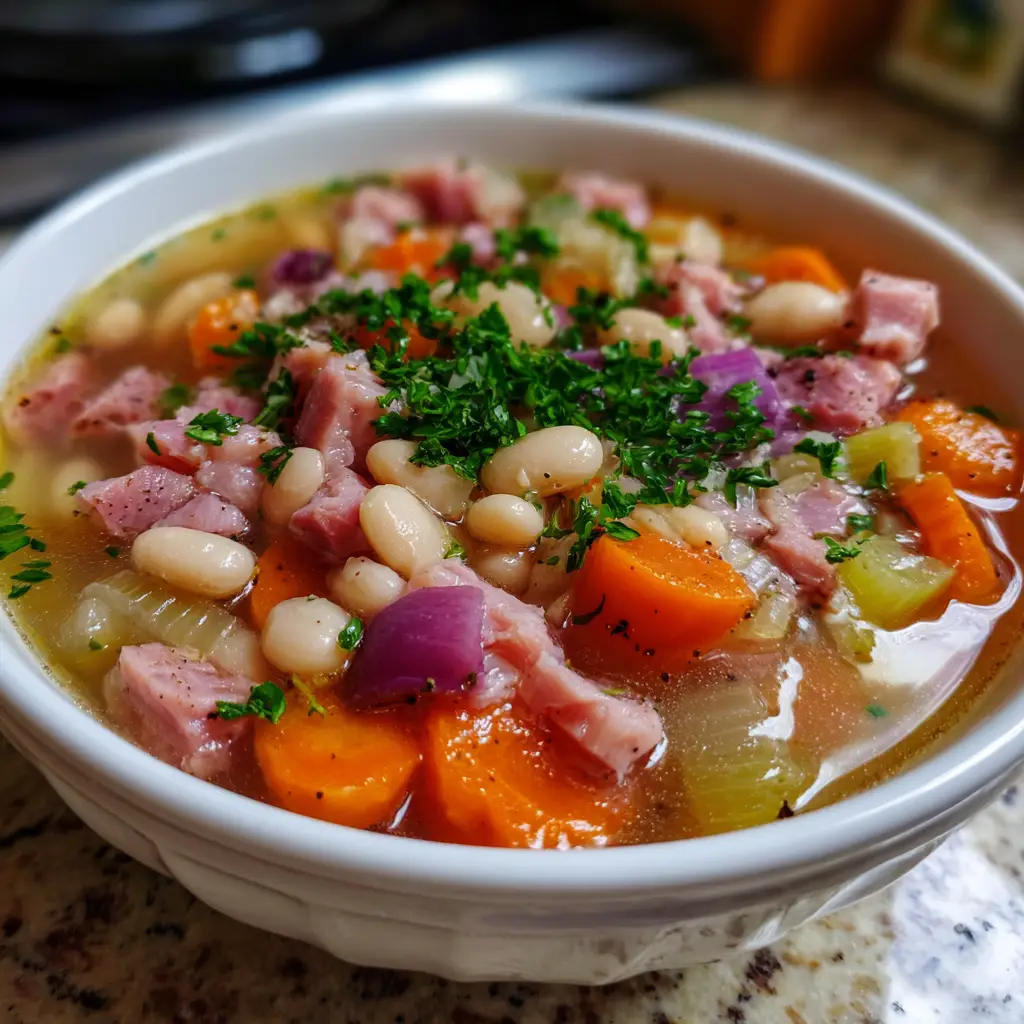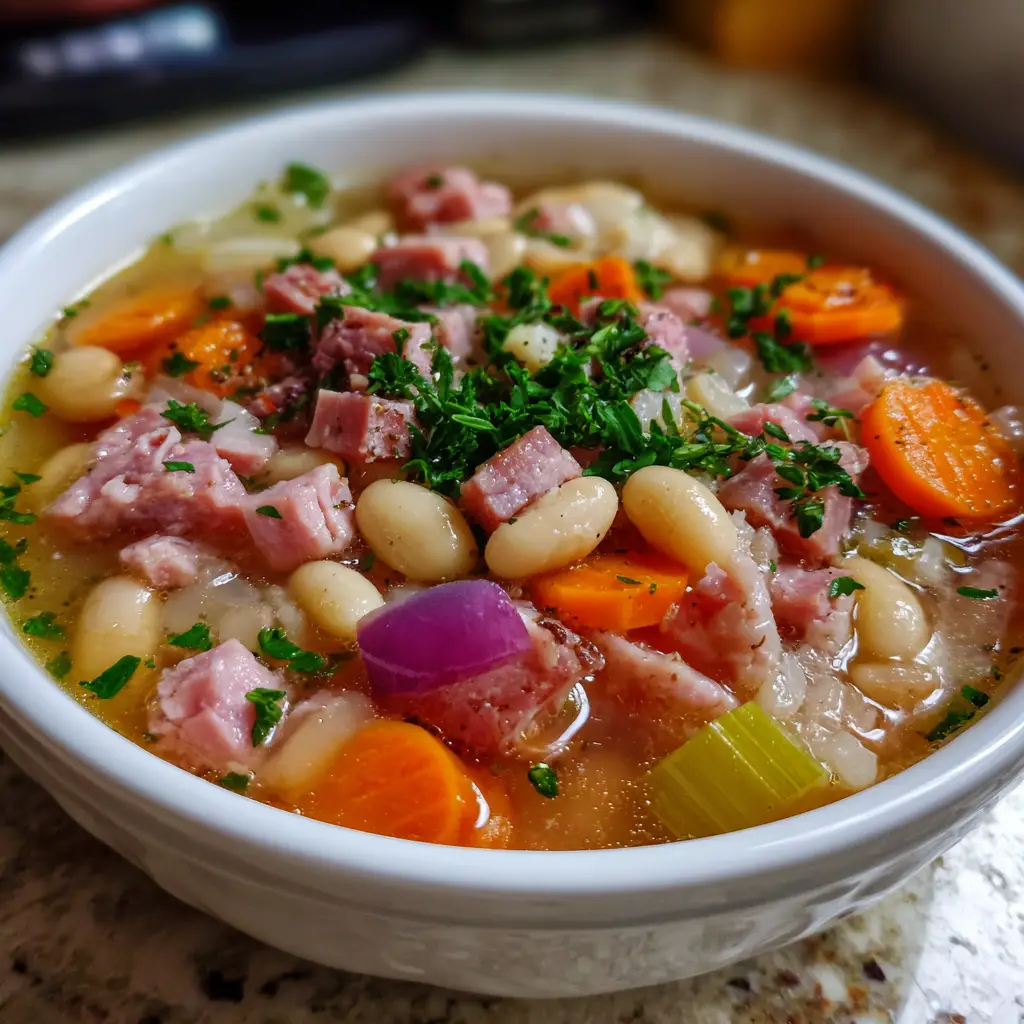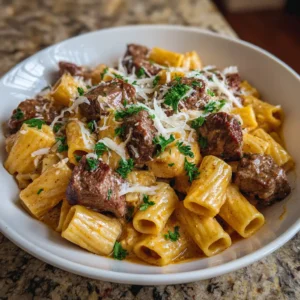Ham and Bean Soup is the very embodiment of rustic, heartwarming comfort food. It is a dish steeped in tradition and frugal ingenuity, a timeless recipe born from the necessity of creating a nourishing, satisfying meal from humble, readily available ingredients. At its core, it is a celebration of transformation, taking a leftover ham bone, a bag of dried beans, and a few simple vegetables, and through the gentle, patient alchemy of simmering, turning them into a culinary masterpiece that soothes the soul and fills the home with an irresistible, savory aroma. This is not a fussy or delicate soup; it is a robust, substantial, and deeply flavorful bowl that speaks to generations of home cooks who knew how to waste nothing and create everything.
Why Is This Ham and Bean Soup So Popular?
The enduring, cross-generational popularity of Ham and Bean Soup is a testament to its fundamental virtues that resonate on a practical, emotional, and gustatory level.
First and foremost, it is the ultimate expression of economical and zero-waste cooking. This soup is traditionally made the day after a holiday ham dinner, providing the most delicious and purposeful second act for the ham bone and any leftover meat. It transforms what might otherwise be discarded into the star ingredient of a new meal, stretching a single ham to feed a family for days. This resourcefulness is not only budget-friendly but also deeply satisfying.
Secondly, it is a profoundly comforting and nostalgic dish. The aroma of ham and beans simmering on the stove is a powerful sensory trigger for many, evoking memories of family gatherings, grandmothers’ kitchens, and a sense of security and home. Its hearty, savory, and straightforward flavor profile is the culinary equivalent of a warm, heavy blanket on a cold night. It provides a sense of well-being and contentment that is universally appealing.
Thirdly, it is incredibly forgiving and customizable. While the classic version is perfection, the recipe is a template that welcomes improvisation. You can use different bean blends, add greens like kale or spinach, incorporate potatoes for extra heartiness, or adjust the herbs and spices to your liking. This flexibility ensures that the soup can be a familiar constant while still allowing for personal expression.
Finally, it is a practical make-ahead meal. Like many soups and stews, Ham and Bean Soup often tastes even better the next day, after the flavors have had more time to meld and intensify. It makes a large batch that freezes exceptionally well, providing ready-made, wholesome meals for busy weeks ahead. This combination of convenience and quality is irresistible to the modern home cook.
Why You’ll Love This Ham and Bean Soup:
- Deep, Savory Flavor: You will be captivated by the rich, smoky, and complex broth, achieved through the slow simmering of the ham bone.
- Incredibly Economical: This soup turns a leftover bone into a feast, offering tremendous value and minimizing food waste.
- Meal Prep Champion: It makes a large quantity that freezes beautifully, ensuring you have delicious, home-cooked meals on hand for days.
- Hearty and Satisfying: Packed with protein, fiber, and vegetables, this is a complete, one-pot meal that will keep you full and satisfied for hours.
- Simple and Straightforward: The process is largely hands-off, requiring simple chopping and patient simmering rather than complex techniques.
Here’s what you’ll need:
The soul of this soup is the ham bone. If you don’t have one leftover from a meal, many grocery stores or butcher shops sell them separately, especially around the holidays.
The Bean Foundation:
- 1 lb (16 oz) Dried Great Northern Beans or Navy Beans (or a mix)
- Water for soaking
The Aromatic Base (Soffritto):
- 2 tablespoons Olive Oil or Butter
- 1 large Yellow Onion, finely diced
- 2-3 medium Carrots, peeled and diced
- 2-3 stalks Celery, diced
- 4-5 cloves Garlic, minced
The Flavor Powerhouses:
- 1 large Meaty Ham Bone (with plenty of ham still attached)
- 8 cups (64 oz) Low-Sodium Chicken Broth or Water
- 2-3 Bay Leaves
- 1 teaspoon Dried Thyme (or 3-4 fresh sprigs)
- 1 teaspoon Black Pepper, freshly cracked
- ½ teaspoon Smoked Paprika (enhances the smoky flavor)
For Finishing and Serving:
- 2-3 cups Cooked Ham, diced
- ¼ cup Fresh Parsley, finely chopped
- 1-2 tablespoons Apple Cider Vinegar or Fresh Lemon Juice (essential for brightness)
- Salt, to taste (be careful, as the ham is very salty)
- Crusty Bread or Cornbread, for serving

How to Make Ham and Bean Soup:
Now that you have your ingredients ready, let’s dive into the steps for making this delightful Ham and Bean Soup. It’s as easy as pie, and I promise you’ll feel like a culinary superstar!
Step 1: Sort and Soak the Beans
Place the dried beans in a large colander and rinse them thoroughly under cold water. Spread them out on a clean surface and pick out any small stones or debris. Transfer the beans to a large stockpot or bowl and cover with at least 2 inches of cold water. Allow them to soak for at least 8 hours or overnight. For a quick-soak method, cover the beans with water, bring to a boil for 2 minutes, then remove from heat, cover, and let stand for 1 hour. Drain and rinse the beans before using.
Step 2: Sauté the Aromatic Vegetables
In a large stockpot or Dutch oven (at least 8 quarts), heat the olive oil over medium heat. Add the diced onion, carrots, and celery. Cook, stirring occasionally, for 8-10 minutes, until the vegetables have softened and the onions are translucent. Add the minced garlic and cook for one more minute until fragrant.
Step 3: Build the Soup Foundation
Place the drained, soaked beans into the pot with the sautéed vegetables. Nestle the meaty ham bone right into the center of the beans and vegetables. Pour the chicken broth over everything, ensuring the ham bone is mostly submerged. Add enough additional water to cover the bone if needed.
Step 4: Season and Simmer to Perfection
Add the bay leaves, dried thyme, black pepper, and smoked paprika to the pot. Stir gently to combine. Bring the soup to a boil, then immediately reduce the heat to low to maintain a gentle, steady simmer. Cover the pot with a lid, leaving it slightly ajar to allow some steam to escape.
Step 5: The Long, Slow Simmer
Let the soup simmer gently for 2 to 3 hours. Stir occasionally to prevent the beans from sticking to the bottom. The soup is ready when the beans are incredibly tender and creamy and the meat on the ham bone is falling-off-the-bone tender.
Step 6: Finalize the Soup
Carefully remove the ham bone from the pot and place it on a cutting board to cool slightly. Once it’s cool enough to handle, use a fork or your hands to shred every bit of meat from the bone. Discard the bone, any fat, and the bay leaves. Return the shredded ham to the pot.
Step 7: Adjust and Garnish
Stir in the 2-3 cups of additional diced cooked ham. This double hit of ham ensures a meaty bite in every spoonful. Now, taste the soup. This is the critical moment to adjust the seasoning. Add the apple cider vinegar or lemon juice—this brightening agent is not optional; it cuts through the richness and makes all the flavors pop. Taste again and only then decide if it needs salt, adding it gradually. Stir in the fresh parsley. For a thicker soup, you can use a potato masher to lightly mash some of the beans against the side of the pot. Serve piping hot.
Tips for Success:
- Do Not Skip the Soaking: Soaking the beans ensures they cook evenly and become tender, and it can help make them easier to digest.
- The Ham Bone is Key: The more meat left on the bone, the more flavorful your soup will be. Don’t be shy about scraping off every last bit.
- Hold the Salt: Do not add salt until the very end. The ham and ham bone release a significant amount of salt as they cook. Salting too early can result in an overly salty soup.
- The Acid is Essential: The tablespoon or two of vinegar or lemon juice at the end is a chef’s secret to balancing the deep, savory, and smoky flavors. Don’t skip it!
- Low and Slow Simmer: A vigorous boil will cause the beans to break apart and make the soup cloudy. A gentle simmer is essential for a clear broth and intact, creamy beans.

Equipment Needed:
- Large Stockpot or Dutch Oven (8-quart minimum)
- Sharp Chef’s Knife and Cutting Board
- Measuring Cups and Spoons
- Ladle
- Colander
Variations of Ham and Bean Soup:
- Slow Cooker Method: After sautéing the vegetables, add them to a slow cooker with the soaked beans, ham bone, broth, and seasonings. Cook on LOW for 8-10 hours or on HIGH for 5-6 hours.
- Instant Pot/Pressure Cooker Version: Sauté the vegetables using the Sauté function. Add the UN-soaked beans, ham bone, broth, and seasonings. Cook on High Pressure for 45 minutes, followed by a natural pressure release for 15 minutes.
- Vegetable-Packed: Add 2 cups of chopped kale or spinach during the last 15 minutes of cooking.
- Creamy Version: For a thicker, creamier soup, stir in ½ cup of heavy cream or half-and-half during the final stage of cooking.
- Spicy Kick: Add a pinch of red pepper flakes with the other dried spices for a subtle heat.
Serving Suggestions for Ham and Bean Soup:
This soup is a meal in itself, but classic accompaniments make it perfect.
- With Crusty Bread: A thick, warm slice of sourdough, French bread, or a crusty roll is mandatory for dipping and scooping.
- With Cornbread: A square of sweet, buttery cornbread is a classic and beloved pairing.
- With a Simple Salad: A side salad with a sharp vinaigrette provides a fresh, crisp contrast to the rich, hearty soup.
- With a Dollop of Condiment: A spoonful of tangy sour cream or a dash of hot sauce can be a delightful finishing touch for individual bowls.
Prep Time:
20 minutes (plus 8 hours for bean soaking)
Cooking Time:
2 hours 30 minutes
Total Time:
10 hours 50 minutes (mostly inactive soaking time)
Nutritional Information (Approximate per serving, serves 8):
- Calories: ~350-400 kcal
- Protein: 25-30 g
- Sodium: ~900 mg
- Sugar: 5 g
- Fat: 8-10 g (Saturated Fat: 2-3 g)
- Carbohydrates: 45-50 g
- Fiber: 12-15 g
Please note: This is an estimate and can vary significantly based on the specific brands of ingredients and portion sizes you use.
FAQs about Ham and Bean Soup:
Q: I forgot to soak my beans overnight. What can I do?
A: Use the “Quick Soak” method: place rinsed beans in a pot, cover with water, bring to a boil for 2 minutes, then turn off the heat, cover, and let sit for 1 hour. Drain and proceed with the recipe.
Q: Can I use canned beans instead of dried?
A: Yes, but the texture and flavor will be different. Use 3-4 (15 oz) cans of Great Northern or Navy beans, rinsed and drained. Add them during the last 30 minutes of simmering to prevent them from becoming mushy. The broth will also be less creamy.
Q: My soup is too thin. How can I thicken it?
A: The easiest way is to use a potato masher to mash some of the beans directly in the pot. Alternatively, you can mix 2 tablespoons of cornstarch with ¼ cup of cold water and stir it into the simmering soup until it thickens.
Q: How long does this soup last in the fridge or freezer?
A: It will keep in an airtight container in the refrigerator for up to 5 days. It freezes exceptionally well for up to 3 months. Thaw overnight in the refrigerator before reheating.
Q: I don’t have a ham bone. Can I still make this?
A: Absolutely. You can use 2-3 ham hocks instead. Or, for a simpler version, omit the bone and use only diced ham (about 4-5 cups total). To compensate for the lost flavor, use a rich chicken broth and consider adding a teaspoon of liquid smoke for that characteristic smoky note.
Final Thoughts:
Ham and Bean Soup is more than a recipe; it is a culinary heirloom, a pot of history and heart. It represents a tradition of making something magnificent from something modest, a lesson in patience and resourcefulness that yields the most profound rewards. This soup is not just about feeding the body; it’s about nourishing the spirit with its deep, comforting flavors and the sense of accomplishment that comes from creating such a timeless dish. The long, slow simmer is an act of care, filling your home with an aroma that promises a meal worth waiting for. So, the next time you find yourself with a leftover ham bone, see it not as an end, but as a beautiful beginning. Embrace the process, and get ready to enjoy one of the most honest, satisfying, and beloved soups in the entire world.




